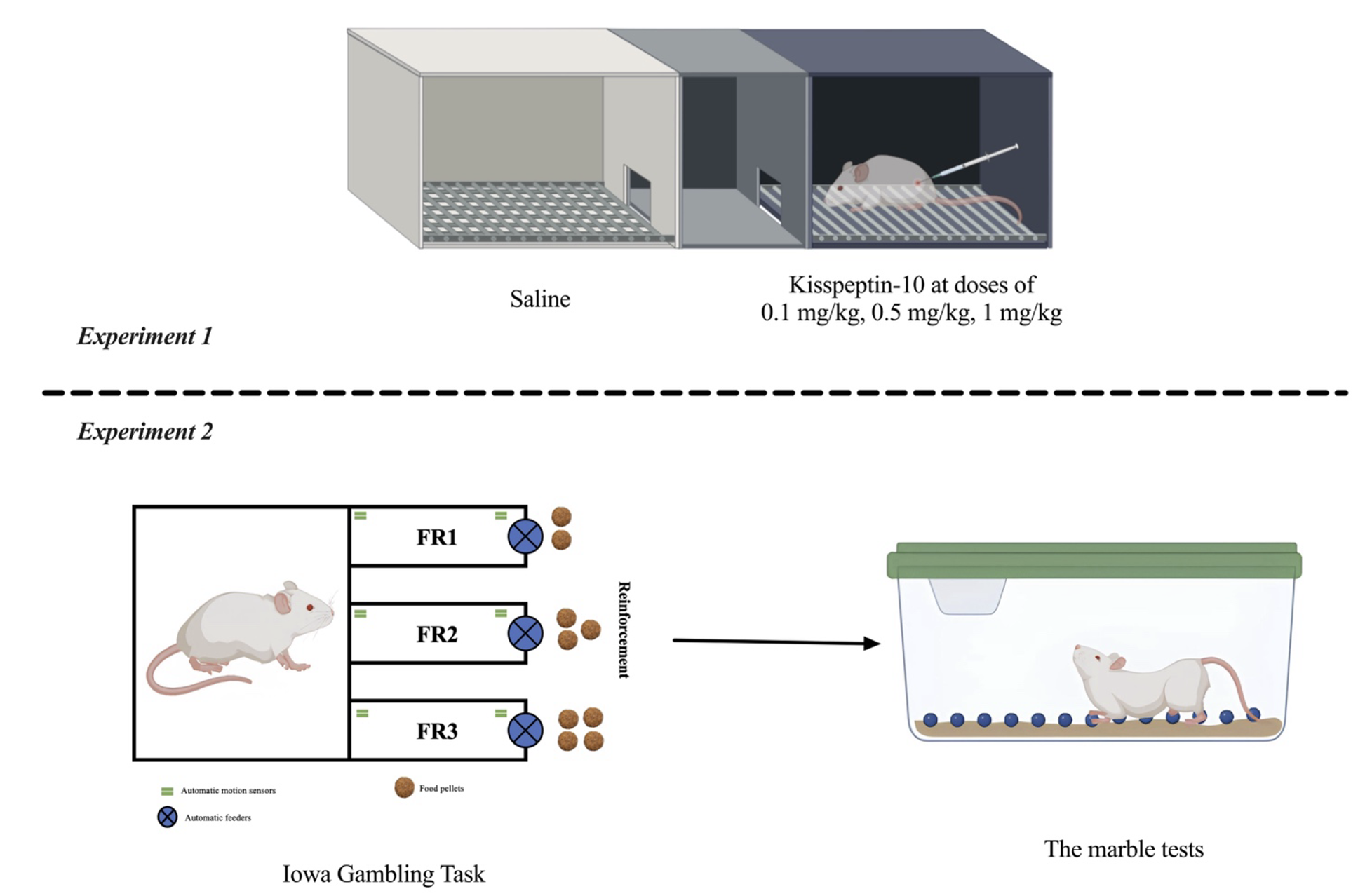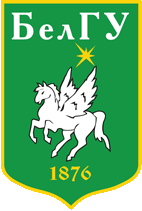Pharmacological analysis of the role of kisspeptin-10 in reinforcing mechanisms
DOI:
https://doi.org/10.18413/rrpharmacology.11.544Abstract
Introduction: Behavioral and substance addictions are driven by shared neurobiological mechanisms, often involving the reward system. Kisspeptin-10, a neuropeptide primarily linked to reproductive functions, has emerged as a potential modulator of reward-related behaviors and decision-making. This study explores the effects of kisspeptin-10 on impulsivity, compulsivity, and reinforcement mechanisms.
Materials and Methods: Male Wistar rats were used to assess the effects of kisspeptin-10 on behavior. A conditioned place preference (CPP) test evaluated reinforcement effects at doses of 0.1 mg/kg, 0.5 mg/kg, and 1 mg/kg. A modified Iowa Gambling Task analyzed decision-making and impulsivity under variable reinforcement schedules. The marble-burying test was employed to assess compulsive behaviors. Statistical analysis included one-way ANOVA and Tukey's post-hoc test.
Results and Discussion: Kisspeptin-10 at 1 mg/kg induced a significant CPP response, suggesting reinforcing properties. In the gambling task, kisspeptin-10 enhanced impulsive choices by increasing preference for riskier reinforcement schedules, contrasting with the stabilizing effects of paroxetine. In the marble-burying test, kisspeptin-10 increased compulsive behavior compared to paroxetine, underscoring its modulatory role in compulsivity. These effects likely reflect kisspeptin-10’s interaction with dopaminergic and serotonergic systems, extending its influence beyond reproductive functions.
Conclusion: Kisspeptin-10 dose 1 mg/kg significantly modulates impulsive and compulsive behaviors, as well as reinforcing mechanisms, highlighting its potential as a therapeutic target for conditions characterized by dysregulated decision-making and compulsivity.
Graphical Abstract

Keywords:
kisspeptin-10, impulsivity, compulsivity, reinforcement, conditioned place preference, behavioral addictionReferences
Aquino NSS, Kokay I.C, Perez CT, Ladyman SR, Henriques PC, Silva JF, Broberger C, Grattan DR, Szawka RE (2019) Kisspeptin stimulation of prolactin secretion requires Kiss1 receptor but not in tuberoinfundibular dopaminergic neurons. Endocrinology 160(3): 522–533. https://doi.org/10.1210/en.2018-00932 [PubMed]
Chakhava VO, Budtueva FS, Borukaev RR (2010) Efficacy of adepress (paroxetin) in generalized anxiety disorder. Korsakov Journal of Neuropathology and Psychiatry [Zhurnal Nevrologii i Psikhiatrii imeni S.S. Korsakova] 110(8): 25–29. [PubMed] [in Russian]
Csabafi K, Ibos KE, Bodnár É, Filkor K, Szakács J, Bagosi ZA (2023) Brain region-dependent alteration in the expression of vasopressin, corticotropin-releasing factor, and their receptors might be in the background of Kisspeptin-13-induced hypothalamic-pituitary-adrenal axis activation and anxiety in rats. Biomedicines 11(9): 2446. https://doi.org/10.3390/biomedicines11092446 [PubMed] [PMC]
Dighton G, Kitchiner N, Larcombe J, Rogers D. et al (2022) Gambling problems among United Kingdom armed forces veterans: Associations with gambling motivation and posttraumatic stress disorder. International Gambling Studies 23(12): 1-22. https://doi.org/10.1080/14459795.2022.20
Franssen D, Tena-Sempere M (2018) The kisspeptin receptor: A key G-protein-coupled receptor in the control of the reproductive axis. Best practice & research. Clinical Endocrinology & Metabolism 32(2): 107–123. https://doi.org/10.1016/j.beem.2018.01.005 [PubMed]
Gibula-Tarlowska E, Grochecki P, Silberring J, Kotlinska JH (2019) The kisspeptin derivative kissorphin reduces the acquisition, expression, and reinstatement of ethanol-induced conditioned place preference in rats. Alcohol (Fayetteville, N.Y.) 81: 11–19. https://doi.org/10.1016/j.alcohol.2019.04.001 [PubMed]
Golts VA, Lebedev AA, Blazhenko AA, Lebedev VA, Bayramov AA, Khokhlov PP, Bychkov ER, Pyurveev SS, Kazakov SV, Shabanov PD (2023) Comparison of anxiolytic effects of mammalian and bony fish kisspeptins in Danio rerio. Psychopharmacology and Biological Narcology 14(2): 85–96. https://doi.org/10.17816/phbn501442 [in Russian]
Goltz VA, Lebedev AА, Eresko SO, Airapetov MI, Pyurveev SS, Bychkov ER, Bayramov AA, Lebedev VA, Shabanov PD (2024) Kiss1 kisspeptin of bony fish and mammalian kisspeptin analogs enhance the communicative behavior of Danio rerio induced by social isolation. Reviews on Clinical Pharmacology and Drug Therapy 22(2): 191–203. https://doi.org/10.17816/RCF625892 [in Russian]
Heitman LH, Ijzerman AP (2008) G protein-coupled receptors of the hypothalamic-pituitary-gonadal axis: a case for Gnrh, LH, FSH, and GPR54 receptor ligands. Medicinal Research Reviews 28(6): 975–1011. https://doi.org/10.1002/med.20129 [PubMed]
Himanshu D, Deepa Sarkar N (2020) A review of behavioral tests to evaluate different types of anxiety and anti-anxiety effects. Clinical Psychopharmacology and Neuroscience: the official scientific journal of the Korean College of Neuropsychopharmacology 18(3): 341–351. https://doi.org/10.9758/cpn.2020.18.3.341 [PubMed] [PMC]
Ibos KE, Bodnár É, Bagosi Z, Bozsó Z, Tóth G, Szabó G, Csabafi K (2021) Kisspeptin-8 induces anxiety-like behavior and hypolocomotion by activating the HPA axis and increasing GABA release in the nucleus accumbens in rats. Biomedicines 9(2): 112. https://doi.org/10.3390/biomedicines90201121 [PubMed] [PMC]
Pyurveev SS, Lebedev AA, Bychkov ER, Shabanov PD (2024) Intranasal administration of ghrelin receptor antagonist [D-Lys-3]-GHRP-6 reduces the manifestations of impulsivity and compulsivity induced by maternal deprivation in rats. Research Results in Pharmacology. 10(2): 97–106. https://doi.org/10.18413/rrpharmacology.10.448
Lebedev AA, Blazhenko AA, Goltz VA, Devyashin AS, Lebedev VA, Kazakov SV, Bayramov AA, Khokhlov PP, Bychkov ER, Shabanov PD (2022) Effects of kisspeptin analogues on the behavior of Danio rerio. Reviews on Clinical Pharmacology and Drug Therapy 20(2): 201–210. https://doi.org/10.17816/RCF202201-210
Lebedev AA, Purveev SS, Sexte E.A, Reichardt BA, Bychkov ER Shabanov PD (2023) Studying the involvement of ghrelin in the mechanism of gambling addiction in rats after exposure to psychogenic stressors in early ontogenesis. Journal of Evolutionary Biochemistry and Physiology 59: 1402–1413. https://doi.org/10.1134/S1234567823040316
Lehman MN, Hileman SM, Goodman RL (2013) Neuroanatomy of the kisspeptin signaling system in mammals: comparative and developmental aspects. Advances in Experimental Medicine and Biology 784: 27–62. https://doi.org/10.1007/978-1-4614-6199-9_3 [PubMed] [PMC]
Mills EGA, Dhillo WS, Comninos AN (2018) Kisspeptin and the control of emotions, mood and reproductive behaviour. The Journal of Endocrinology 239(1): R1–R12. https://doi.org/10.1530/JOE-18-0269 [PubMed]
Mills EGA, O'Byrne KT, Comninos AN (2019) Kisspeptin as a behavioral hormone. Seminars in Reproductive Medicine 37(2): 56–63. https://doi.org/10.1055/s-0039-3400239 [PubMed]
Pastuszak AW, Badhiwala N, Lipshultz LI, Khera M (2013) Depression is correlated with the psychological and physical aspects of sexual dysfunction in men. International Journal of Impotence Research 25(5): 194–199. https://doi.org/10.1038/ijir.2013.4 [PubMed]
Putteeraj M, Soga T, Ubuka T, Parhar IS (2016) A ”timed” kiss is essential for reproduction: lessons from mammalian studies. Frontiers in Endocrinology 7: 121. https://doi.org/10.3389/fendo.2016.00121 [PubMed] [PMC]
Seminara SB, Messager S, Chatzidaki EE, Thresher RR, Acierno JS, Jr, Shagoury JK, Bo-Abbas Y, Kuohung W, Schwinof KM, Hendrick AG, Zahn D, Dixon J, Kaiser UB, Slaugenhaupt SA, Gusella JF, O'Rahilly S, Carlton MB, Crowley WF, Jr Aparicio SA, Colledge WH (2003) The GPR54 gene as a regulator of puberty. The New England Journal of Medicine 349(17): 1614–1627. https://doi.org/10.1056/NEJMoa035322 [PubMed]
Sivalingam M, Parhar IS (2022) Hypothalamic kisspeptin and kisspeptin receptors: Species variation in reproduction and reproductive behaviours. Frontiers in Neuroendocrinology 64: 100951. https://doi.org/10.1016/j.yfrne.2021.100951 [PubMed]
Tanaka, M, Csabafi K, Telegdy G (2013) Neurotransmissions of antidepressant-like effects of kisspeptin-13. Regulatory Peptides 180: 1–4. https://doi.org/10.1016/j.regpep.2012.08.017 [PubMed]
Tissen IY, Lebedev AА, Tsikunov SG, Shabanov PD (2023) Kisspeptin reduces sexual dysfunction in a rat model of posttraumatic stress disorder. Psychopharmacology & Biological Narcology 14(4): 237–244. https://doi.org/10.17816/phbn623033 [in Russian]
Tissen IY, Chepik PA, Lebedev AA, Magarramova LA, Bychkov ER, Shabanov PD (2021) Conditioned place preference of kisspeptin-10. Reviews on Clinical Pharmacology and Drug Therapy 19(1): 47–53.https://doi.org/10.17816/RCF19147-53 [in Russian]
Published
How to Cite
Issue
Section
License
Copyright (c) 2025 Sarng S. Pyurveev, Andrei A. Lebedev, Eugeny R. Bychkov, Petr D. Shabanov

This work is licensed under a Creative Commons Attribution 4.0 International License.
 Русский
Русский
 English
English

